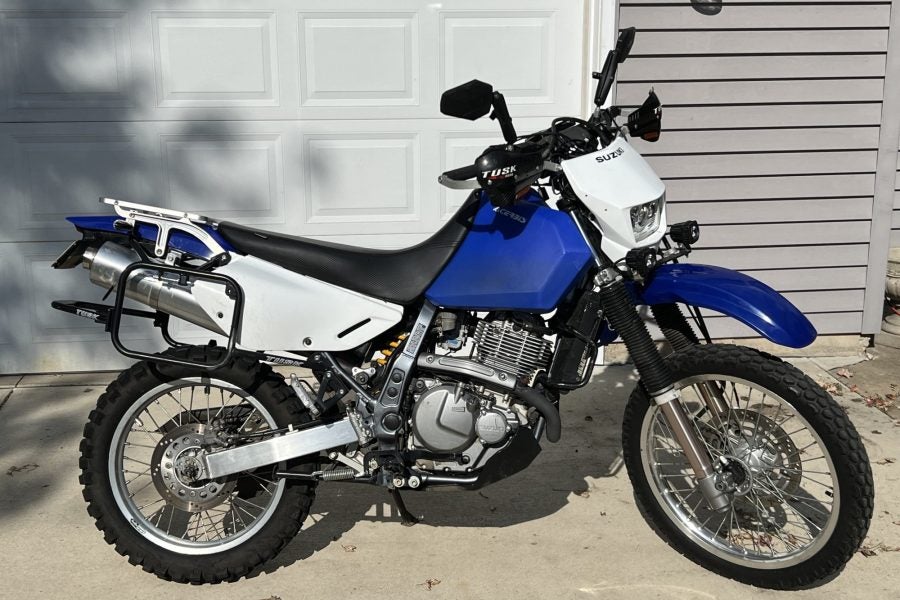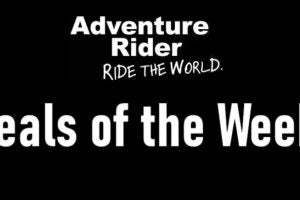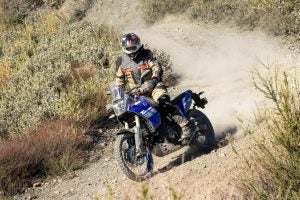What’s the greatest motorcycle of the 1980s? I tell people all the time: The Suzuki DR650 is the pinnacle of 1980s motorcycle design. It’s true, the current model was introduced in 1996 (which is still almost 30 years ago). But in its ’96 update, Suzuki took some of the best ideas from the ’80s (big bore four-strokes and SACS cooling), and sold them to the public at a very affordable price.
Evolution of the DR
The DR650 is a single-cylinder air/oil-cooled dual sport. Our current model is a direct descendant of the DR600, Suzuki’s big-bore four-stroke that debuted in the mid-1980s. The DR600 had a lot of vibration and didn’t have an electric start—no wonder people preferred the KLR650 from Kawasaki in the late ’80s. When the 600 became a 650 around 1990 (depending which market you were in), it was still kick-only, even if the engine was otherwise much-improved. Again, no wonder people preferred the Kawasaki competition, although the Suzuki was certainly more of an off-road machine than the KLR.

The SACS-cooled engine uses a design that debuted in the 1980s (really, it owes its genesis to Japanese military aircraft engines from the 1940s). Photo: @D3M
But when Suzuki introduced the updated model in 1996, it did everything right. Now, the machine had an improved chassis, an electric start, and an updated SACS design. These were all key to the bike’s success.
First, the chassis. Suzuki spent a lot of time working with dual sport riders to determine what they wanted, actually sending head office staff out to dealerships to figure out what buyers wanted. Of course they wanted better suspension, but they also wanted a lower seat. Along with a more sensible stock seat height, Suzuki answered by designing a bike that could be lowered even further with minimal cost. You flipped some parts around inside the fork, reversed the shock linkage and added a lowered kickstand (or cut/welded the original). Nobody else did this then, and more than two decades later, nobody’s doing it now.
Then there was the e-start. This was an obvious upgrade, and Suzuki ditched the kicker at the same time.
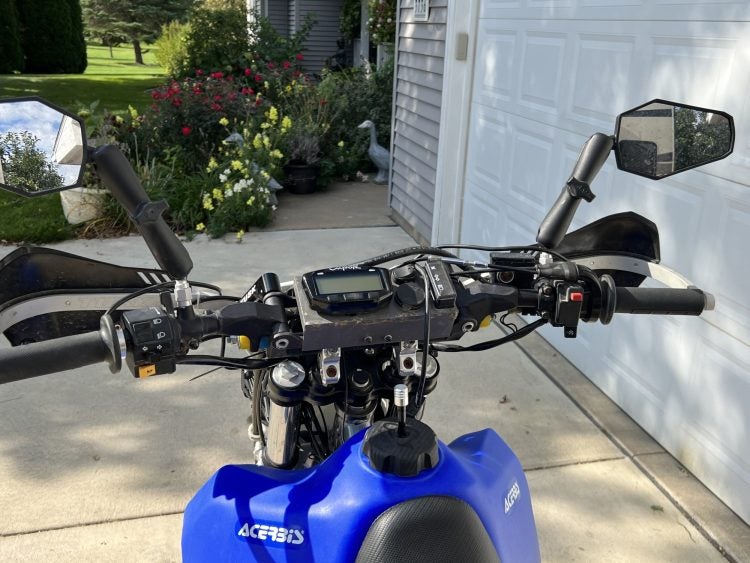
A cockpit that doesn’t look stock, but doesn’t look complicated either. Note that a Parabellum windshield is included with the sale, but not seen here. Photo: D3M
And then there was SACS—standing for Suzuki Advanced Cooling System. This sounds like a fancy-pants liquid-cooled design. What it really was, was a cleverly-engineered oil-cooling system. The rad hanging off the bike’s right hand-side cooled the engine oil, and then a system of internal jets squirted used that oil to cool important parts. It was built on the same ideas the Suzuki had used on its superbikes in the 1980s, modified to the world of dual sports. It was an incredibly efficient and smart way of keeping an engine running cool without adding a lot of extra parts.
Motojournalists were quick to praise the new bike; guys like Peter Egan and David Edwards always said good things about it in Cycle World. I think the moto-public was a little slower in their excitement, perhaps because the KLR was such strong competition. But when the Gen 1 and Gen 1.5 KLRs were pushed out the door for the 2008-edition overhaul, a lot of riders began looking much more seriously at the Suzuki 650. I think that generational update from Kawasaki was the best thing that ever happened to the DR650.
With all this interest, you’d think Suzuki would incrementally update the 650, even if it didn’t do a ground-up overhaul. And, you’d be wrong. With the exception of a couple of minor updates (a new base gasket, threadlocker on the NSU bolts), the DR650 is practically unchanged since 1996. Any further evolution has come from the aftermarket.

A tidy rack that can carry a load, but won’t get in the way in the dirt. Photo: D3M
Farkling up!
The ’96-edition DR650 was good in stock form, particularly if you’re a talented rider and realistic in your expectations. However, there was much room for improvement. Buyers soon began to upgrade the fork, beefing up the internals or adding cartridge emulators or even swapping out the front end. Same for the shock.
The stock DR seat was crap (and still is, decades after its introduction). The factory offered a comfortable alternative; the aftermarket offered many other options that were even better.
The stock carb was OK, but could be updated for more power. Many owners swapped the carb out completely, with the Mikuni TM40 pumper carb probably the most popular mod. One well-known wrencher from DR fandom switched his bike over to EFI.
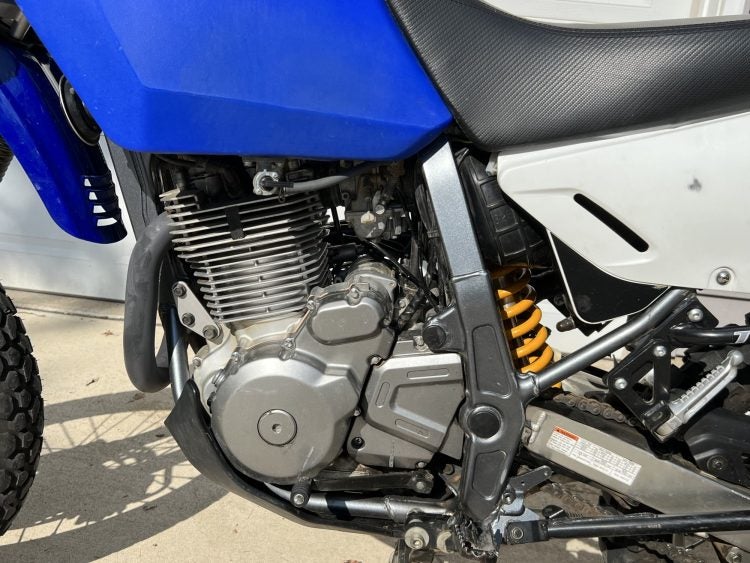
There are many solutions for the wimpy response of the stock carb, ranging from jet kits to homebrewed EFI. Photo: @D3M
There were many other updates available: larger gas tanks, luggage racks, rally fairings, heated grips, LED lights, high-power charging systems. But the most hairy-chested update of all was the 790 kit.
Big-bore kits for the DR650 have been around a long time. At first, they were around the 725 cc mark, then 780 cc. Now, the biggest available over-the-counter is the 790 kit sold by ProCycle (the go-to for most DR650 upgrades). This kit only requires the owner to bore out the cylinder and install a larger piston and rings—no splitting the cases to install a longer con-rod. You can read plenty of reports on the DR790 kits in ADVrider’s forum, and at this point, I would not be surprised if there were more DR790s on the street than there are DR800s. The OG DR800 “Doctor Big” had a short sales run in the US, as the largest production single ever. Now, an aftermarket kit takes the 650 even larger than that machine (about 10 cc more capacity), while keeping weight lower. For those reasons, it’s a very attractive upgrade for many owners, if they have the patience and skill to do the work themselves.

LED lights cut a path through the night much more efficiently than the stock halogen light. Photo: @D3M
Ready to ride
Of course, the other way to get your hands on an upgraded bike is to buy it! Here’s a 2004-edition DR650 with the 790 kit and many other upgrades, for sale in ADVrider’s Flea Market. Here’s how seller @D3M describes it:
2004 DR790 – $5250 OBO – Cash only, 8000 miles
This motorcycle is adventure ready. It has a long list of improvements.
Procycle 790 big bore kit
TM 40 Mikuni pumper carb
Open air box
Ground header weld with O2 sensor bung welded in near heat shield
GSXR muffler with mid pipe by Barry of DR650 you tube video fame
Cogent Dynamics Drop in Cartridges
Cogent Dynamics Mojave Shock
Heavier springs front and back
Fast Flexx anti vibration handlebars
Rox Handlebar risers
Seat concepts seat
Trail tech Vapor speed / tach / oil temp
Tusk pannier racks
Tusk hand guards with LED turn signals
Tail tidy rear fender
LED stoplight with light pulser
Rear rack
Center stand
Rear LED turn signals
Auxiliary LED lights
Voltmeter / USB port on dash
Folding mirrors
Parabellum wind screen (not mounted currently)
ACERBIS 5.3 gal tank
Composite bash plate
18 inch rear wheel
That machine has pretty much everything you need, if you want the DR650 developed to the furthest it can go; while you may want individual systems replaced with different parts, as a whole, almost everything has been addressed. $5,250 might sound like a lot of dough for an almost-20-year-old DR650, but these parts would have cost a lot more than the seller is recouping here. Plus, the work of installation would have taken many hours of work. If you’re interested, see the ad here.


